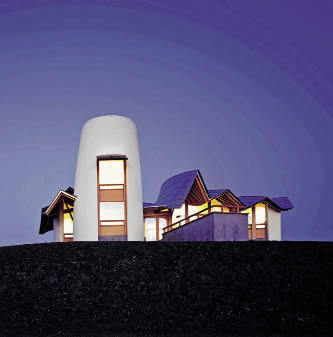It was the neon lit windowless corridor in the surgery in Dumfries that did it. It was June 1993 when Maggie Keswick and her husband Charles Jencks heard the prognosis that she had two to three months to live as the breast cancer had spread to her liver and her bones. In fact Maggie was to live fighting the disease for another 18 months — she died on 8 July 1995. But she lives on every day through her inspired idea that cancer patients need a place to deal with the facts of what she called ‘the dreaded disease’. She wanted to show that things need not be so awful, that patients are not victims and that self-help is possible if you can be in the right kind of place.
This book is moving, ambitious and brave. Moving because it is highly personal; ambitious because it discusses the huge problem of modern buildings for health, and brave because, like Maggie Keswick, it is not afraid to challenge medical orthodoxy. Charles Jencks writes with a poignant strength about the whole experience he shared with his wife and how he has used his knowledge of contemporary architecture and the inspiration of Maggie’s memory to work incredibly hard to get the Caring Centres built. His co-author, Edwin Heathcote, himself a recent cancer patient, contributes a telling essay on the 3000-year history of medical buildings. He argues powerfully against the latest giant NHS hospitals, calling them ‘urban aberrations’, places that are industrial in concept. He rightly quotes the timeless words of Plato: ‘This is the great error of our day in the treatment of the human body; that physicians separate the soul from the body.’
In the 15 years since her death some 12 Maggie’s Centres have been developed. Six are built and functioning and six are underway. Inevitably, Charles Jencks’s own career as a leading architectural guru has enabled him to invite his friends, who happen to be top architects, to design the centres. But the brief for all the centres is modest, and extravagant personal statements are not on. I liked the story of Frank Gehry’s dream. When he was commissioned to design a centre for Ninewells hospital in Dundee he was the most famous architect in the world because of his triumphant Guggenheim Museum in Bilbao. He produced a design with a Babel-like spiral tower and roofs parting like the waves of the Red Sea. While he was developing his design Maggie appeared to him one night in a dream. ‘Calm it down Frank’, she said — and he did. His simple Dundee centre is like a lovely chapel with a view over a garden maze, beautifully designed by Arabella Lennox-Boyd.
Zaha Hadid in Kirkaldy, Fife, doesn’t hold back. From the outside, her angular black centre looks angrily at the hospital, but inside all is calm and white, and giant windows bring in the healing light and green view.
In London, Richard Rogers was commissioned to build on a tricky site alongside the 1970s pile of Charing Cross Hospital, and as a close friend of Maggie and Charles (he describes Jencks as ‘off the wall’) he has produced a very untypical building for his practice. It is much friendlier than one would expect and has a log fire and feels like a cosy, colourful village school, sheltering under its big eaves from the neighbouring NHS giant. Again, Maggie’s wishes for architects to design places that reflect comfort and caring have won through.
The list of future projects includes a design in concrete by the Japanese architect, Kisho Kurokawa, to be built posthumously in Wales; a timber-clad centre in Cheltenham by Richard MacCormac and an achingly trendy, partly underground landscape building by Foreign Office Architects in Newcastle.
What Maggie Keswick wanted were places which she called ‘havens’, and this is happening, particularly as the centres are independent from their hospital settings, and patients can use them without medical referral. More important than the architectural styles is the idea that they should be informal and domestic and focussed around the kitchen. The aim is to make patients feel that they have an importance at a difficult time and that their wisdom is recognised. When she was very ill in the Western General Hospital in Edinburgh, Maggie worked on the plans for the first centre to be built at that hospital in a converted stable. She would have liked the remarkable way that, since then, the centres have transformed personal cancer care by letting in the light and giving hope. May they flourish.






Comments